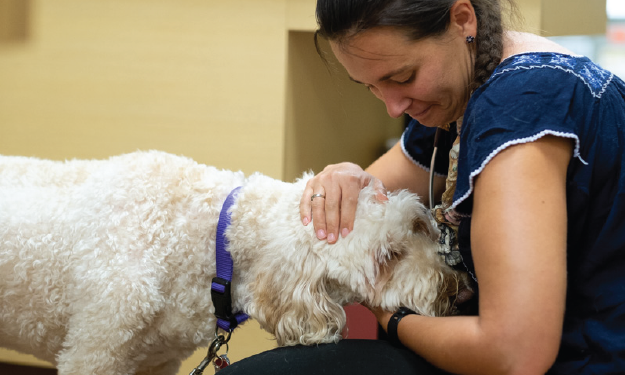Spinal Tumors in Dogs

What Types of Nervous System Tumors are there?
Nervous system tumors are more common in dogs than in cats. The most common locations for nervous system tumors are the brain and spinal cord. The most common type of brain and spinal cord tumors include meningiomas, followed by gliomas, however, other tumor types such as lymphoma have been reported.
What are the Symptoms?
Symptoms vary depending on the location of the primary tumor, but typically include non-specific signs and a wide range of neurologic signs. This can range from ataxia, behavioral changes and seizure activity. These signs often temporarily improve with symptomatic treatments, such as anti-inflammatory medications and antiepileptic medications.
How are they Diagnosed?
Diagnosis usually involves thorough examination, neurological examination and advanced imaging. An MRI is theimaging modality of choice for the nervous system. Imaging and biopsy findings help to determine the prognosis and direct treatment. Depending on the location of the mass, a biopsy may not be feasible, and therefore accurate classification of the tumor type cannot be made. Imaging characteristics of the mass may be more suggestive of histologic subtype.
What are the Treatment Options?
- Surgery: Surgery provides immediate decompression and improvement of clinical signs depending on tumor location. Surgery allows for histologic diagnosis of the mass. In some cases, combining surgery with other treatments has been associated with improved tumor control and outcomes.
- Radiation Therapy: Radiation therapy is the primary treatment of choice for tumors that are not surgically resectable, or in the post-operative setting. Radiation results in resolution or improvement of clinical signs in the majority of patients. Long-term outcomes and side effects from treatment vary depending upon the stage and type of tumor.
- Chemotherapy: There is limited information regarding efficacy of chemotherapy for brain and central nervous system tumors. There are a limited number of chemotherapy agents thatconcentrate within the nervous system.
- Medical management: Medical management of nervous system tumors depends on what the clinical signs are, but often involves antibiotics to treat secondary infections, and/or anti-inflammatory drugs.
What is the Prognosis?
There are many factors that may influence the prognosis of animals with nervous system tumors. The specific tumortype is important, severity of neurological dysfunction, as well as aggressiveness of therapy. Without treatment, theaverage prognosis is 2-3 months. The average prognosis with radiation treatment for most animals is 8-12 months, although it may be better or worse depending on the tumor type and stage. Patients with brain and spinal cord tumors treated with surgery and adjuvant radiation had an average prognosis 14-18 months.
What Course(s) of Radiation are Recommended?
Definitive radiation therapy is our recommended protocol for most patients; it involves daily treatments for 3.5-4weeks given on a once daily schedule Monday through Friday. Many other protocols and treatment techniques have been attempted in an effort to either improve long-term outcomes, and/or reduce side effects, depending on specific treatment circumstances and goals. Specifically, there are techniques that involve giving higher radiation doses over a shorter time in an effort to improve long-term outcomes (stereotactic radiation therapy or SRT). There are alsopalliative radiation courses that have fewer treatments and side effects. Your radiation oncologist can discuss these potential alternative approaches with you.
What Side Effects May be Seen with Radiation Therapy of Central Nervous System Tumors?
Side effects are limited to the treatment field, which depends on the extent of the tumor. The risks related to anesthesia and acute tumor swelling during treatment can be seen. Potential side effects secondary to radiation include minimal acute skin effects, possible delayed-acute effects to the brain or somnolence, and low risk of severe late effects such as necrosis. Your pet may be prescribed antibiotics and/or anti-inflammatory medications to manage these reactions; analgesics can also be prescribed if needed. Your pet should be encouraged to eat soft, moist foods during the treatment and recovery period. Acute radiation effects usually get progressively worse, until about 2 weeks after completion of therapy, and then heal over the next 2-4 weeks.
With any radiation protocol there is a low (<5%) risk of serious late effects, which can be complications due to treatment, typically seen 1-5+ years after treatment. Your radiation oncologist will discuss any specific concerns regarding radiation side effects based on your pet’s treatment field.